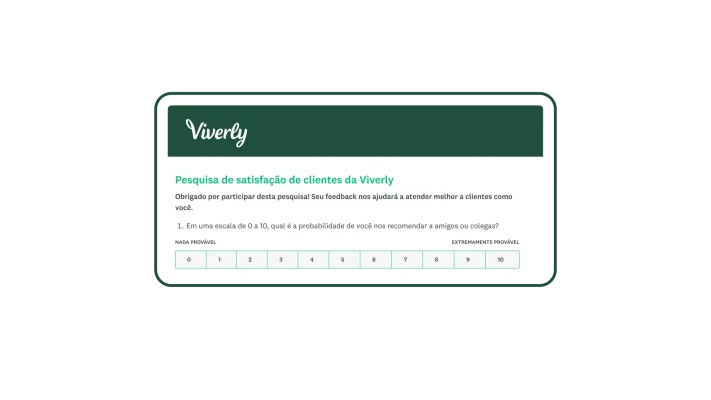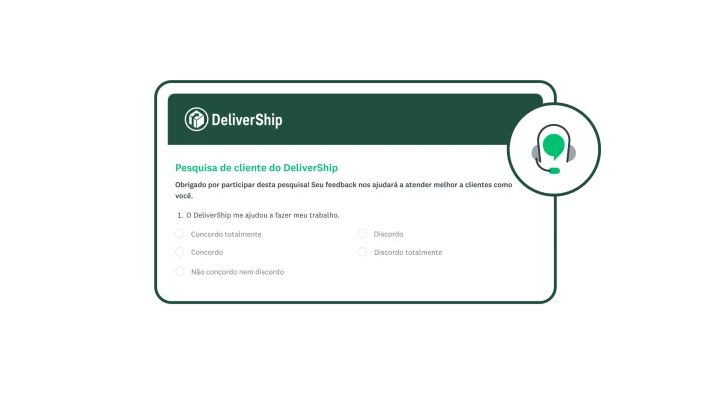Como criar um programa de Voz do Cliente de sucesso

Quando foi a última vez que você evitou uma marca porque escutou algo negativo sobre ela? Você alguma vez já parou de comprar de alguma loja que te decepcionou?
Quantas vezes você entrou em contato com essas empresas para dizer por que não vai mais comprar delas?
Se você está a cargo de melhorar a experiência de clientes, não pode esperar que os consumidores procurem por você para passar essas informações. Em vez disso, você deve começar essas conversas defendendo, implementando e mantendo o programa de voz do cliente (VoC) da sua organização.
Mas o que seria um programa de voz do cliente?
A Voz do Cliente é a coleta, a análise e o monitoramento de forma sistemática das interações dos clientes com seu produto, serviço ou sua marca.
Um programa de voz do cliente é importante para a experiência de clientes que você oferece. Ela é essencialmente um compromisso de reagir ao feedback dos clientes com medidas práticas. Seu objetivo inicial é alinhar a expectativa dessas pessoas ao desempenho da sua organização. Quando você mantém um programa de voz do cliente eficaz, você também ajuda sua equipe a exceder as expectativas.
A diferença entre um programa de voz do cliente e apenas uma coleta de feedback
Muitas organizações pedem feedback para clientes por meio de questionários, formulários e grupos focais. Mas um programa de voz do cliente não é apenas uma coleta de feedback. Quando você cria um programa de voz do cliente, você está tornando o envolvimento, a fidelidade e a satisfação de clientes uma parte fundamental da sua estratégia de negócios. Um bom programa de voz do cliente inclui:
- Objetivos concretos
- Apoio da liderança
- Participação e envolvimento de colaboradores
- Uma compreensão ampla da trajetória de clientes
- Escuta proativa de clientes em todos os canais e pontos de contato
- Pesquisas de mercado e de clientes em intervalos regulares
- Análises de dados e geração de relatórios
- Comunicação interna
O mais importante de tudo é que um bom programa de voz do cliente deve ser prático. As empresas priorizam fechar o ciclo de feedback dos clientes identificando pontos de queixa, corrigindo problemas e comunicando essas mudanças aos clientes e também aos colaboradores.
Continue lendo para saber como criar seu próprio programa de voz do cliente, desde o planejamento até a implementação e sua manutenção. Você verá dicas, métricas importantes e recursos como estes modelos de questionário de voz do cliente para te ajudar a começar.
Como criar seu programa de voz do cliente
1. Obtenha o aval da liderança da empresa para criar um programa de voz do cliente
Preparar um programa de voz do cliente ou até renovar um que já existe exige tempo e recursos. Antes de lançar um plano completo, colete as seguintes informações e apresente o plano para a liderança para obter seu aval:
- Pontos de queixa importantes dos clientes ou métricas preocupantes (como um aumento ter 5% na rotatividade de clientes a cada ano).
- Como o seu programa é ou como acha que ele poderia ser.
- Alguns estudos de caso de outras empresas que mostrem como é importante priorizar escutar seus clientes e reagir a isso. Como quando a empresa estadunidense de ônibus Greyhound aumentou uma métrica de fidelidade de clientes em 15 pontos e fez mudanças cruciais na sua experiência de clientes, aumentando sua rentabilidade.
2. Trabalhe com outros envolvidos para definir os objetivos
Depois que tiver conquistado o apoio da liderança, colabore com as outras equipes da empresa. Cada equipe envolvida terá sua própria perspectiva sobre a experiência de clientes e diferentes maneiras de melhorá-la.
- Os departamentos de sucesso de clientes, de serviços e de atendimento trabalham diretamente com a clientela, por isso sabem as principais queixas e os problemas do seu produto ou serviço.
- Os departamentos de marketing e comunicação terão insights sobre o mercado e a concorrência. Eles também podem ter contato direto com clientes por meio das redes sociais.
- O departamento de vendas terá uma boa ideia da sensibilidade de preço, além dos produtos e das soluções dos concorrentes e que tipo de mensagem funciona ou não funciona para converter novos clientes.
- As equipes de produtos podem ajudar a entender como as pessoas interagem com seu produto ou serviço, incluindo dados como rotatividade e taxa de abandono. Elas também podem ajudar a obter uma compreensão abrangente de como os produtos funcionam e quaisquer problemas que possam estar afetando a satisfação.
- Um departamento de recursos humanos ou de operações têm perspectivas sobre a experiência de colaboradores. Eles estão comprometidos? Eles sentem que conseguem afetar de forma positiva a experiência de clientes?
Cada uma dessas equipes pode ter objetivos ou ideias de sucesso diferentes. Para começar, você pode escolher um objetivo central para toda a empresa (por exemplo, “aumentar a taxa de satisfação de clientes em 10%”) e incentivar cada equipe a definir seu próprio objetivo.
Mas lembre-se de que isso é um trabalho centrado no cliente. Uma equipe de produtos pode querer melhorar a experiência de integração de clientes para obter mais inscrições. Mas no contexto de um programa de voz do cliente seria melhor suas equipes de produto e de atendimento trabalharem juntas. A equipe de atendimento poderia indicar pontos de queixa importantes na experiência de integração, e a equipe de produtos poderia resolvê-los com o objetivo de reduzir o número de tickets de suporte e reclamações.
3. Crie um mapa da trajetória de clientes
Faça reuniões com outras equipes para pensar sobre como um cliente ou possível cliente interage com sua marca antes durante e depois de uma compra. Isso é conhecido como mapeamento da trajetória de clientes e pode ajudar a descobrir oportunidades de coletar feedback, saber mais sobre determinado ponto de contato ou resolver falhas na experiência de clientes. Existem pontos de contato com o cliente antes durante e depois de uma compra. Alguns exemplos incluem:
- Antes da compra: anúncio, indicação ou redes sociais
- Durante a compra: site ou ponto de venda
- Depois da compra: pagamento, comprovantes por email e central de ajuda online
Ao criar um mapa da trajetória de clientes, tenha em mente também quando, onde e com que frequência você pede feedback para eles. Isso ajudará a aperfeiçoar como você planeja e monitora suas pesquisas.
Precisa de ajuda para criar um mapa da trajetória de clientes?
Aprenda a criar um mapa para unificar a visão e alcançar os objetivos de todos os departamentos sobre a experiência de clientes.
4. Escute os clientes regularmente
Ao escutar seus clientes, você coleta feedback de (quantitativo e qualitativo) de VoC.
Dados estruturados são quantificáveis ou mensuráveis. Por exemplo, você envia uma pesquisa que pede para os clientes avaliarem a probabilidade de eles comprarem de você novamente. Como você está pedindo para eles escolherem entre algumas opções definidas, o resultado terá um valor numérico: 76% dos clientes dizem que comprariam seu produto novamente.
Dados não estruturados são qualitativos ou imensuráveis. Por exemplo, em uma pesquisa de experiência de compra, você pede para a pessoa explicar por que ela indicou que muito provavelmente compraria de você novamente. Você fornece uma caixa de texto onde essa pessoa explicará sua resposta. As respostas de texto ajudam você a entender os motivos por trás dos números.
Para ter uma visão completa da experiência de clientes, é uma boa ideia coletar ambos os tipos de dados. Estas são algumas maneiras de escutar regularmente os clientes como parte de um programa de VoC:
- Colete feedback com questionários de satisfação de clientes em pontos de contato importantes, como após uma compra ou uma interação com o atendimento ou o suporte.
- Incentive as equipes de diferentes departamentos da empresa a se reunir com os departamentos mais próximos dos clientes, como o de vendas e o de atendimento, uma vez a cada trimestre.
- Faça pesquisas com clientes ou usuários regularmente para obter insights da concorrência e ver onde é possível melhorar seu produto ou serviço.
- Conduza grupos focais e entrevistas para obter insights aprofundados.
- Pratique escuta social para entender a percepção das pessoas sobre sua marca.
5. Colete métricas fundamentais de voz do cliente
Existem algumas métricas padrão de VoC usadas por empresas para entender a experiência de clientes. Estas são três das mais populares.
Net Promoter Score (NPS)

Qual é a probabilidade de alguém recomendar sua empresa para um amigo ou colega? A pesquisa de Net Promoter® Score (NPS) fornece uma resposta quantificável e fácil de monitorar. Esta é uma visão geral da pesquisa de NPS:
- Cálculo simples de NPS: os respondentes dão uma nota de 0 a 10, e o índice resultante é um número de −100 a +100.
- Monitorável e conveniente: a pergunta de NPS é simples e versátil, seja para perguntar se uma pessoa recomendaria a sua marca, seu produto, aplicativo ou software. Ela não é vinculada a nenhum evento específico, por isso é um bom indicador de como sua organização está se saindo em determinado momento.
- Referências comparativas: como muitas organizações usam o NPS, você pode comparar seu índice com o de outras empresas do seu setor. Por exemplo, nossa análise de centenas de pesquisas de NPS mostram que 38 é o índice médio do setor da saúde.
Índice de satisfação de clientes (CSAT)

Enquanto o NPS mostra sua fidelidade de clientes ao longo do tempo, o índice de satisfação de clientes (CSAT) ajuda a entender como uma pessoa se sente após uma interação específica com sua marca. Coisas para saber sobre a pesquisa de CSAT.
- Funciona bem com a de NPS: tanto o CSAT quanto o NPS são métricas de VoC importantes que oferecem insights diferentes sobre a experiência de clientes.
- Específico e prático: use as pesquisas de CSAT para fazer melhorias específicas na experiência de clientes. Você pode obter feedback de atendimento ou medir a satisfação dos visitantes do seu evento para obter feedback.
- Fácil de calcular e analisar: as opções de resposta de uma pesquisa de CSAT são baseadas em uma escala numérica, como a de 1 a 5. Você pode olhar os dados brutos (por exemplo, 478 clientes disseram que ficaram muito satisfeitos com sua interação recente com o atendimento) ou você pode ver os dados como porcentagens.
Índice de esforço de clientes (CES)

Qual é o nível de facilidade ou dificuldade para os clientes de realizar certas tarefas ao interagir com sua empresa? O índice de esforço de clientes (CES) ajuda a identificar pontos de desgaste importantes na experiência, como ao usar seu software ou tentar resolver um determinado problema. A seguir, estão alguns motivos para usar pesquisas de CES para aperfeiçoar seu programa de VoC.
- Melhorar a fidelidade de clientes: de acordo com nossa pesquisa, 91% dos consumidores tendem mais a recomendar uma empresa se tiverem uma experiência de baixo esforço.
- Encontrar maneiras rápidas de melhorar: uma mensagem confusa pode ser suficiente para fazer um cliente abandonar uma compra. E se apenas mudar algumas palavras do processo de finalização de compra já pudesse melhorar sua rentabilidade?
- Criar programas de treinamento melhores: você pode fazer pesquisas de CES para descobrir onde sua equipe de atendimento está deixando a desejar; por exemplo, se seus representantes estão demorando muito para resolver o problema do cliente. Quando você sabe que tipo de interação está difícil para seus clientes, é possível adaptar o treinamento da sua equipe de atendimento para resolver problemas comuns mais rápido.
6. Analise os resultados
Quando começar a coletar feedback de clientes em diferentes pontos de contato, você deve examinar cada bloco de dados e comparar suas descobertas.
- Peça para seus colegas de outras funções compartilharem os insights que eles colheram dos clientes de pesquisas de mercado, de canais das redes sociais e outros meios. É interessante tornar todas essas informações acessíveis em um só lugar, como em um wiki interno ou um site.
- Alguns dados, como os de NPS, são fáceis de interpretar. Mas se estiver coletando feedback aberto nas suas pesquisas com clientes, use uma ferramenta de análise de texto para descobrir tendências ocultas.
- Processe os dados de pesquisa com ferramentas de análise avançadas, como filtros personalizados. Elas podem enriquecer os resultados da pesquisa com insights de clientes muito mais profundos.
7. Reaja, mantenha e repita
Depois que já tiver criado uma estratégia de escuta de clientes que funcione, preste atenção e reaja a quaisquer problemas imediatos que possam aparecer, como uma queda no NPS ou um índice de satisfação de clientes baixo.
A longo prazo, você precisa criar uma estrutura para manter um programa de VoC sólido para sua organização. Veja algumas ideias.
- Influenciar o mapa de progresso de um produto: a equipe de produtos pode se comprometer a corrigir um ou dois problemas urgentes uma vez por trimestre.
- Melhorar o treinamento e a resposta da equipe de atendimento: as equipes de atendimento e suporte podem priorizar uma experiência de integração de colaboradores melhor com um treinamento de empatia. Ou elas podem preparar modelos de respostas pré-prontas para as perguntas mais frequentes de clientes, reduzindo o tempo de resposta.
- Envolver a empresa inteira: dedique uma ou duas semanas a cada semestre para focar em resolver problemas de clientes ou responder a um feedback importante.
- Manter os clientes no centro da sua empresa: convide regularmente alguns clientes para contar suas histórias para seus colaboradores.
- Compartilhar sucessos e fracassos: considere enviar um relatório mensal para todos da empresa dando destaque a um feedback importante, tendências de dados e histórias de clientes para motivar o pessoal.
Vantagens de um programa de Voz do Cliente
Quando seus clientes estão satisfeitos, eles tendem mais a permanecer fiéis à sua marca e a recomendá-la para outras pessoas. Mas existem outras vantagens de um programa de VoC que podem não ser tão óbvias.
Melhorar o envolvimento de colaboradores
Quando você cria um programa de VoC, você dá a seus colaboradores as ferramentas para mudar diretamente a experiência dos clientes. Você pode até incentivar sua equipe a definir objetivos centrados no cliente e recompensá-los por alcançar esses objetivos.
Obter uma vantagem competitiva
Grande parte de uma coleta de feedback é reativa, o que significa que você só consegue entender como os clientes se sentem depois de uma interação com sua marca. Um programa de VoC também leva em conta a coleta de feedback proativo. Grupos focais, entrevistas, escutas em redes sociais e pesquisas com usuários são todas maneiras de encontrar oportunidades para desenvolver novas ideias de produto, resolver queixas dos consumidores e muito mais.
Obter ainda mais depoimentos de clientes e provas sociais
Você pode usar um feedback de cliente e interações positivas para mostrar narrativas poderosas sobre sua marca em vários canais, desde folhetos e banners até um site próprio e plataformas de redes sociais.
Como superar desafios comuns que seu programa de VoC pode enfrentar
Desafio 1: feedback e dados de clientes isolados em cada departamento
Pesquisas de mercado, insights de usuários, feedback de atendimento, interações em redes sociais e resultados de pesquisa: os dados trabalham juntos para criar uma imagem completa da experiência de clientes. Mas se os dados estiverem separados em departamentos diferentes, fica difícil identificar tendências e oportunidades importantes para outras equipes da sua organização.
Cada departamento deve ser responsável por divulgar suas descobertas ou compartilhá-las todas em um só lugar. Você pode simplificar a coleta e o manuseio de feedback usando integrações de pesquisas da SurveyMonkey com o Salesforce, o HubSpot, o Mailchimp, o Zendesk, o Zoom e outras ferramentas.
Desafio 2: os clientes não estão respondendo às pesquisas de feedback
Está enviando pesquisas mas não recebe respostas suficientes para obter resultados estatisticamente relevantes? Como parte do seu programa de VoC, considere fazer uma auditoria da sua pesquisa passando cada uma delas por uma lista de pontos de práticas recomendadas.
Os clientes podem estar ignorando suas pesquisas porque as acham muito longas ou confusas. É uma boa ideia usar modelos de questionário e perguntas prontas de satisfação de clientes criados por especialistas para obter respostas confiáveis.
Ainda não sabe por que suas pesquisas não estão dando resultado? Confira estas dicas de como melhorar a taxa de resposta de CSAT e como escrever boas perguntas de CSAT.
Desafio 3: algumas equipes não estão interessadas em aderir a essas pesquisas
Se a ideia de manter os clientes satisfeitos não for suficiente para convencer algumas equipes a priorizar esse projeto, pode ser necessário vincular a satisfação de clientes à rentabilidade da empresa. Por exemplo, você pode demonstrar o retorno sobre os investimentos em melhorar a satisfação vinculando o valor total das vendas para um cliente fidelizado ao número de pessoas que dizem que comprariam de você novamente.
Fortaleça seu argumento compartilhando pesquisas convincentes com as equipes relutantes. Nosso estudo mostra que 75% dos clientes perdem a confiança em uma empresa depois de uma experiência ruim com o produto, além de outras descobertas importantes.
Cinco práticas recomendadas para criar um programa de voz do cliente
Desenvolva um programa de VoC que capture as opiniões dos seus clientes. Use as seguintes práticas recomendadas para envolver seus clientes em um diálogo, alinhar diferentes departamentos da sua empresa e fazer mudanças impactantes.
- Preste atenção em dados implícitos. Dados implícitos, como de uso de um aplicativo ou a taxa de rotatividade, são o contrário do feedback explícito dos clientes. Os clientes podem te dizer que estão satisfeitos com seu aplicativo, mas se eles não o usarem outra vez é hora de fazer mais perguntas.
- Antes de começar sua análise de dados, filtre os dados da pesquisa para obter os resultados mais precisos e práticos possíveis.
- Provavelmente, quanto mais satisfeitos seus colaboradores estiverem, melhor será a experiência de clientes. Trabalhe junto com o RH para monitorar o envolvimento de colaboradores e a satisfação, por exemplo com uma pesquisa de eNPS. Você pode até monitorar métricas importantes de envolvimento de colaboradores como o eNPS e compará-las ao NPS de clientes.
- Contextualize seus resultados. Obviamente, você está monitorando a satisfação dos clientes ao longo do tempo. Mas você também quer comparar seus resultados com os da concorrência para ter uma visão relativa do seu desempenho.
- Mantenha seu programa de voz do cliente atualizado. Estude as principais tendências de experiência de clientes, incluindo como os profissionais de CX estão navegando pela era da IA e trabalhando para atender as novas expectativas dos consumidores.
Comece a criar seu programa de Voz do Cliente hoje mesmo
Envie uma pesquisa em minutos usando um destes modelos de questionário de voz do cliente criados por especialistas. Se precisar de um pouco mais de ajuda, veja como a SurveyMonkey pode ajudar em seu programa de VoC.
Net Promoter, Net Promoter Score e NPS são marcas comerciais da Satmetrix Systems, Inc., Bain & Company, Inc. e Fred Reichheld.
Conheça outros recursos

Soluções para sua função no trabalho
Trabalhe melhor com a ajuda da SurveyMonkey. Saiba como criar estratégias vencedoras e mais impactantes para produtos, suas experiências e muito mais.

Hornblower melhora sua experiência de clientes global
Descubra como a Hornblower usa a SurveyMonkey e a IA avançada para aproveitar os dados do NPS, coletar insights e melhorar a experiência de clientes.

Guia definitivo de satisfação dos clientes: oito táticas para melhorar
O que é satisfação dos clientes? Saiba o que é e como medi-la e conheça oito estratégias para ter sucesso com este guia completo.

Guia do índice de esforço de clientes (CES): o que é e como usá-lo
Saiba como medir a satisfação e a experiência de clientes com a pontuação de esforço do cliente. Este guia mostra o que você precisa saber.